Times & Dates ESL Games, Activities & Worksheets
My Calendar
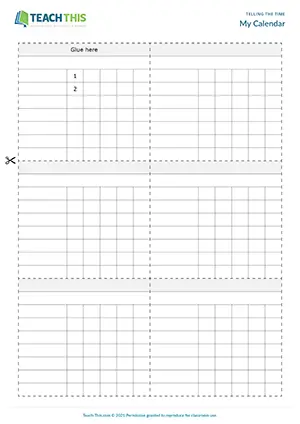
ESL Make a Calendar Activity - Vocabulary: Labelling, Ordering
In this creative make-a-calendar activity, students create a calendar and fill it with special days or dates such as birthdays, festivals and national holidays. First, students learn and practice the rhyme "Thirty days have September...
Missing Dates
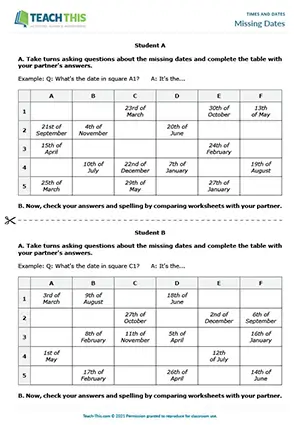
ESL Saying Dates Activity - Speaking: Information Gap, Asking and Answering Questions - Pair Work
In this free saying dates activity, students practice ordinal numbers, months and dates. In pairs, students take turns asking questions to fill in the missing dates in a table, completing it with their...
Miyu's Mystery Timetable
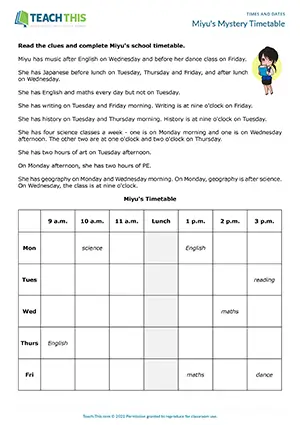
ESL School Timetable Worksheet - Reading Exercise: Table Completion
This interesting school timetable worksheet is ideal for practicing time, parts of the day, days of the week, and school subjects. First, students read clues about Miyu's school timetable and fill in the missing subjects. Afterwards, draw the...
Telling the Time

ESL Telling The Time Worksheet - Vocabulary Exercises: Matching, Writing Short Answers, Drawing
In this comprehensive telling the time worksheet, students learn and practice telling the time using numbers and expressions 'past' and 'to'. Students begin by matching time expressions to the number...
Telling the Time Dominoes

ESL Telling the Time Game - Vocabulary: Matching - Group Work
This enjoyable telling the time game helps students practice saying the time with 'past' and 'to' by matching written times to times on digital clocks. The first student puts a domino down, either before or after the domino on the table, making sure the...
Terry's Timetable
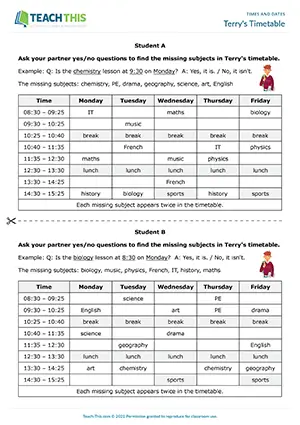
ESL Timetable Game - Speaking: Information Gap, Guessing, Asking and Answering Questions - Pair Work
In this fun school timetable game, students practice telling the time, time prepositions and school subjects. In the game, students ask a partner yes/no questions to find the missing subjects in Terry's timetable...
Time Around the World

ESL Time Around the World Activity - Speaking: Asking and Answering Questions - Pair Work
In this useful time zones activity, students practice asking and answering questions about the time in different cities around the world. First, in pairs, students take turns asking their partner...
Time Bingo

ESL Telling the Time Game - Vocabulary: Matching
In this productive telling the time game, students practice various ways of telling the time. In the game, students play multiple rounds of bingo to practice different times, starting with o'clock times. First, students draw a different time on...
Time Pelmanism Game

ESL Telling the Time Games - Vocabulary and Speaking: Matching, Forming Sentences - Pair Work
In these two free telling the time games, students match times to clock picture cards and practice saying the time. In pairs, students take turns turning over one clock picture card and one...
Timetable Battleships

ESL School Timetable Game - Speaking: Guessing, Asking and Answering Questions - Pair Work
In this engaging timetable game, students play battleships by trying to find six English lessons in a partner's school timetable. First, students write six English lessons in a timetable. Students then...
Vocabulary Clocks
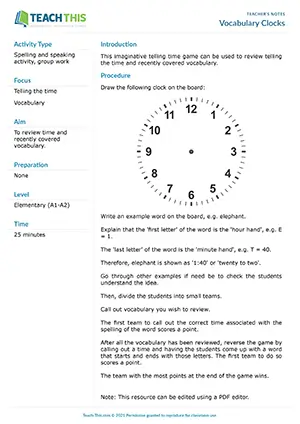
ESL Time Game - Vocabulary: Matching, Spelling - Group Work
This imaginative time game helps students practice telling the time while reinforcing recently covered vocabulary and spelling. First, draw a clock on the board. Next to each number, write letters of the alphabet. The first letter of the word is the...
When is your birthday?

ESL Saying Dates Activity - Speaking: Asking and Answering Questions
In this rewarding saying dates activity, students practice asking and answering questions about birthdays while exchanging imaginary gifts. First, students write the date of their birthday on a card that shows a gift-wrapped present and...
Find Someone Who...
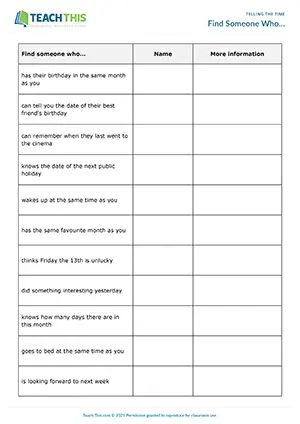
ESL Time Activity - Speaking: Asking and Answering Questions, Controlled and Freer Practice
In this insightful 'Find Someone Who' activity, students practice asking and answering questions about time. First, students go through the items on the worksheet and form the yes/no questions they...
Hear and Say
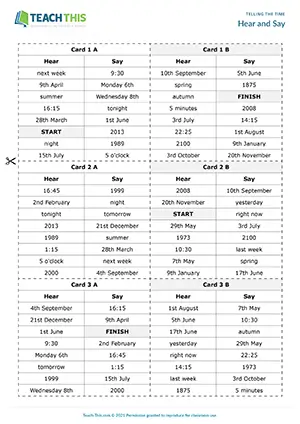
ESL Saying Times Game - Listening and Vocabulary: Matching - Group Work
This entertaining time expressions game helps students practice telling the time, time prepositions and saying days, months, years, dates and other time expressions. In groups, the student with 'start' on their card begins by saying the time expression...
Just Another Day
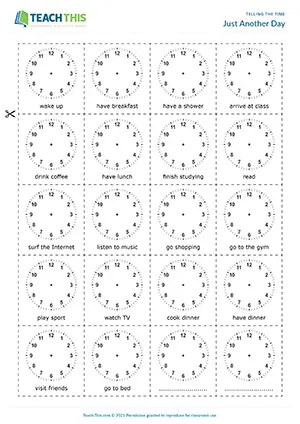
ESL Telling the Time Activity - Speaking: Ordering, Forming Sentences, Freer Practice - Pair Work
In this free telling the time speaking activity, students practice saying times and using the present simple to describe a partner's daily routine. First, students select cards that represent activities they do...
Our Time
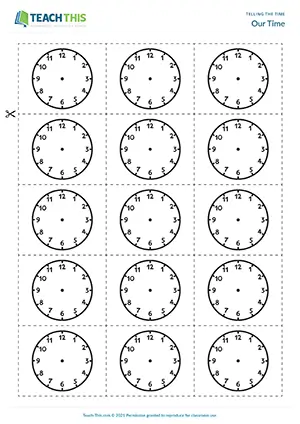
ESL Saying Times Activity - Speaking: Asking and Answering Questions, Ordering, Forming Sentences, Freer Practice
In this productive saying times activity, students practice asking about and explaining times in their daily routine, as well as sequencing and describing daily activities using the present simple...

